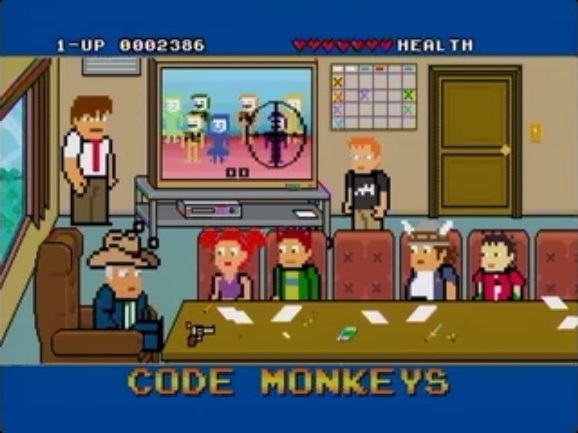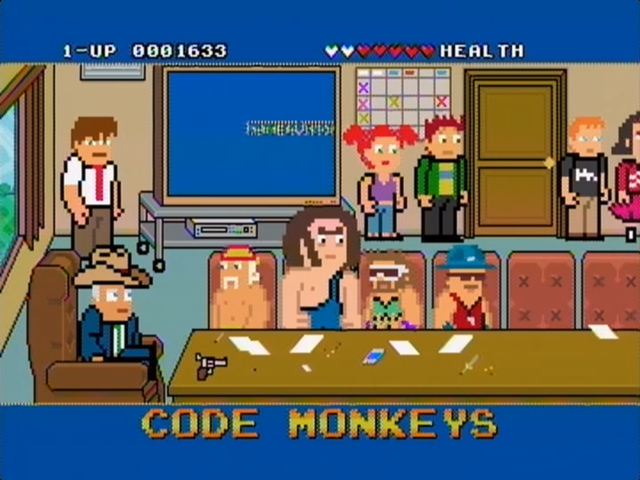Showcase Inventory
Created by Adam de la Pena
Produced by Jennifer Saxon Gore and Tony Strickland
Aired on G4 for two seasons (26 episodes) from July 11, 2007 – August 17, 2008
Cast
Adam de la Pena as Dave
Matt Mariska as Jerry
Andy Sipes as Bob “Big” T. and Dean Larrity
Dana Snyder as Todd and Benny
Tony Strickland as Black Steve
Gretchen McNeil as Mary
Suzanne Keilly as Clare
Show Premise
Set during the home entertainment boom of the early 1980s, the show follows the daily lives of the video game programmers of a fictional company by the name of GameAvision. The episodes regularly focus on two employees: Dave, a slacker programming savant and Jerry, his office mate/workhorse. The series begins when former CEO owner Steve Wozniak sells the company to a wealthy tycoon named Bob Larrity, who has his own ideas on how to run GameAvision. The series stems a lot of its conflicts from the workers trying to appease the new owner and his often unusual demands. The other workers include Mary, a hardworking yet undermined and under-appreciated female video programmer, Black Steve, the company African American accountant who is called “Black Steve” despite there being no other Steve at the company, and Todd, an egotistically naïve video game programmer who is often the butt of the joke.
The show is often filled with video game references and features cameos of actual game developers as guest voices. There are also many pop culture references of the 1980s era that come into play, all with the awareness and foresight of things to come. The humor is generally low brow and purposefully offensive, in the vein of South Park or Family Guy.
Series Run
After having worked on Minoriteam, a short lived Adult Swim animated series, Adam de la Pena went on to develop Code Monkeys, which he originally pitched under the title of Dave and Jerry vs. the World. He produced seven minutes of test animation to show to networks and settled on G4, as their audience had the most potential to appreciate a video game-style narrative TV series. The title changed to Code Monkeys after they had gained the rights to use geek culture songwriter Jonathan Coulton’s song as the theme music. All of the episodes were directed by Adam de la Pena while all but the last few episodes were written by him. The animation and narrative of the series is in the style of the average 8-bit games of the 1980s. The most notable aspects of the series’ animation is the purposeful use of the bars found on the top and bottom of the screen that keep true to the 8-bit video games that would use those spaces to inform the player of carrying items, energy levels, and points acquired. Essentially, it was the ideal series for an audience that was familiar with video games’ visual cues and language. The show received mixed reviews that mostly panned the crude humor and seemingly obscure nostalgia references.
Although the series was designed for the video gaming audience, it didn’t garner enough interest from G4 viewers to get renewed for a third season, nor does it appear to have a cult audience now. It’s uncertain, but perhaps the series was too referential to gamer culture, making it not appeal to the general audience that exists outside of it. It also may not have been able to connect with the millennial gamer audience as the references being made were to games they had likely not been exposed to. There is also the possibility that the gaming community didn’t appreciate the portrayal of the characters, who represented them as stoners, narcissists, and hypersexualized and/or depraved.
This show has been compared to South Park at times for its use of atypical animation and crude humor, but where it differs is in the characterization of the main cast. South Park has at least some sensible characters to ground the series, but in Code Monkeys there are no sensible characters to relate to. Everyone is off the wall, an exaggeration or non-heroic. If anything, this show may have more in common with the sitcom Seinfeld, as viewers can watch these characters be self serving and weird but still appreciate the somewhat relatable or familiar situations they are in.
The series follows the adventures of main video game programmers Dave and Jerry who work at GameAvision. Dave is an obnoxious slacker who abuses Jerry with pranks and insults, while Jerry works hard and dreams about impressing fellow coworker Mary, a man-hating repressed female game programmer. To parallel Mary there is Clare the receptionist, who is a stereotypical boy-crazy girl. Another programmer is narcissist D&D weirdo Todd, who is so close to the edge of nuts that he can snap any minute. There is also Black Steve, who is very much the stereotype of the angry black man as much as the music programmer Clarence is the stereotypical gay man. Another stereotype character is Bob Larrity, the wealthy Texan CEO of GameAvision who is amoral and sexist with a son named Dean who is as dumb as brick.
This show is definitely not for everyone, but it can be very rewarding for viewers that understand gamer culture, history, and pop references from the 1980s. There is also a lot of low brow humor in the series that involves a lot of talk of masturbation, pants wetting, microwaving poop, and sexual depravity. The show is episodic, with every episode telling standalone stories. In the rare occasion when it does refer to something that happened in a previous episode, it clarifies the plot point simply in order to move the story along. The animation is very nostalgic of the 8-bit games of the 1980s with scenes and sounds and visual cues that are meant to remind audiences of particular games. Although the jokes and gags are at times very crude, the pixel art that they are presented in really helps give a sense of separation from the gross-out humor and therefore makes the gag a little bit funnier than it would’ve been if it had been done in live action. The bars at the top and bottom of the screen also mine more jokes into the narrative of the average episode, giving an almost a Meta narration in the commentary placed in those spaces. For example, when a character like Todd begins to show signs of going off the rails, the top would show a bar representing “Todd’s Crazy Factor” and have it fill like a health meter to a breaking point. There is some really clever humor amongst the raunchiness that really makes this series a stand out.
Here are some series highlights:
Season 1
Episode 2, “E.T.”: This episode may be particularly relevant now, considering the recent discovery that the long-thought myth of the landfill full of discarded E.T. video games has turned out to be true. The GameAvision gang is commissioned by Steven Spielberg to produce a video game based off of his just-released feature film E.T. and end up botching it when Dave, instead of watching the film in order to give game details to overworked Jerry, sells his ticket to M Night Shyamalan and spends the money at a strip club.
Episode 5, “Just One of the Gamers”: A fun spin on the 1980s film Just One of the Guys, where a girl pretends to be a guy in order to gain the benefits denied to her because of her gender. In this case the girl is Mary, who changes herself to Mitch and the results are hilarious.
Episode 9, “Todd Loses His Mind”: This is one of the most interesting episodes of the series, showcasing Todd at his most off kilter.
Season 2
Episode 2, “Psychological Problems: In this episode, everyone gets psychoanalyzed and are found to be a little bit crazy. None more than Todd though, who has lost his mind again after having invented a new video game, “Cock Goblin”, without realizing it to be the explicit joke that it clearly is. Extra points for this episode making a The Sopranos reference despite it being set in the 1980s.
Episode 3, “My Pal Jodie”: Dave gets implicated in a conspiracy to kill the president when his game My Pal Jodie gives a Taxi Driver-inspired fan the idea to enact the assassination attempt in order to impress Jodie Foster. Bonus points for referencing George Micheal having orgy sex in public restroom as a TETRIS game.
Episode 4, “Dave Gets Boobs”: One of the more nonsensical yet funny episodes of the series has Dave realize that he doesn’t need women anymore after he decides to get breast implants and reap all the benefits he can from it, but then also realizes all of the cons that go with having large breasts as well.
Preservation Claim
Code Monkeys is an animated series unlike any other of its time or even now. The cleverness of the format and visual style is not being represented anywhere currently and, for what it’s worth, it worked well for this series. It is hard to say why this series didn’t attract a wider audience while it was on the air, because currently there is a series about Silicon Valley and programming that is doing fairly well. Maybe there is no television market for gaming community because games already have a narrative built in, meaning fans of the genre do not need to see non-interactive narratives play out on their screen. 2014 heralded the fall of the G4 network and perhaps it was warranted because of the lack of demand for a television network devoted to gaming. Perhaps the community is just too internet savvy to watch a cable television channel. This animated series, though, is a corner stone of the media in some ways and hopefully in the future there will be a place for this kind of storytelling or even an innovative way to use the video game cues that were utilized on this series. As it stands now, there is only one DVD set of the first season and a second season with no official release. It would be nice if someday it got one.
Adam de la Pena went on to produce web series On the Bubble, then animated series Your Dungeon My Dragon for XBOX Live, MSN, and Youtube. His latest project is been an animated series called OUTLANDS for Geek & Sundry site.
Dana Snyder has since done voice work on animated series Aqua Teen Hunger Force, SuperJail!, Bob’s Burgers, and Adventure Time.
Availability
Just before the show was cancelled there was DVD release for season one from Shout Factory, which was a two disc set containing all 13 season one episodes, a behind the scenes feature, and some promo videos. After the show was cancelled, there was little demand for a second season DVD set as to up until this day there is still no release nor are there any plans for one. There is information on the DVD set at the Shout Factory website and there are also some video clips available to view at the G4 website. The show was available to stream on Netflix a few years ago, but has since been dropped.
Amazon:
The season one DVD set is available for purchase at Amazon.





